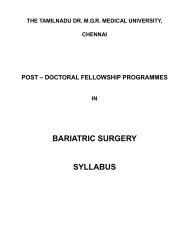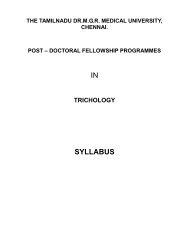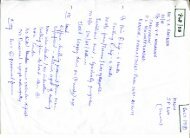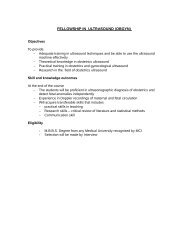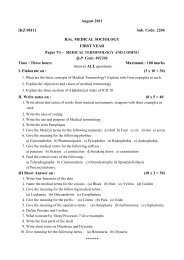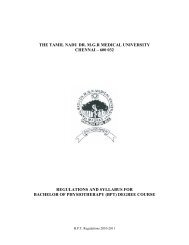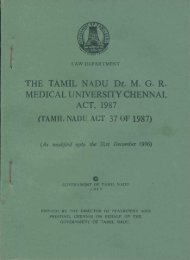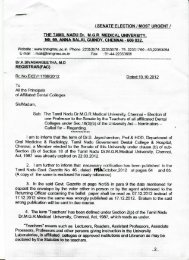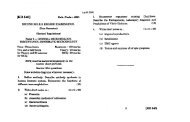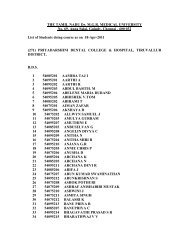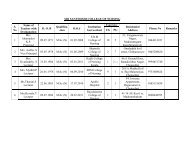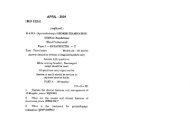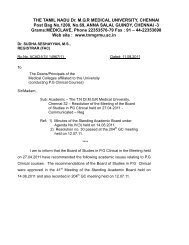P.G. Diploma in Diabetes Education Regulations - Tamil Nadu Dr ...
P.G. Diploma in Diabetes Education Regulations - Tamil Nadu Dr ...
P.G. Diploma in Diabetes Education Regulations - Tamil Nadu Dr ...
Create successful ePaper yourself
Turn your PDF publications into a flip-book with our unique Google optimized e-Paper software.
1<br />
THE TAMIL NADU <strong>Dr</strong>.M.G.R MEDICAL UNIVERSITY, No. 69, ANNNA SALAI<br />
GUINDY, CHENNAI-600 032.<br />
REGULATION FOR THE POST GRADUATE DIPLOMA IN<br />
DIABETES EDUCATION<br />
OBJECTIVE:<br />
1. To provide the participant with the knowledge and skills of the education<br />
process to enable them to be effective diabetic educators<br />
2. To tra<strong>in</strong> and shape the candidate with variety of teach<strong>in</strong>g modules,<br />
3. To <strong>in</strong>culcate sense of compassion and listen<strong>in</strong>g to patient needs,<br />
4. To develop excellent communication skills<br />
1. ELIGIBILITY FOR ADMISSION:<br />
A candidate should passed <strong>in</strong> B.Sc –Nutrition, Food service Management<br />
and Dietetics / Food Service Management and Dietetics / Cl<strong>in</strong>ical Nutrition &<br />
Dietetics / Food & Nutrition / Nutrition, Dietetics & Food Service Management /<br />
Food Science and Nutrition / Nurs<strong>in</strong>g –B.Sc Nurs<strong>in</strong>g / <strong>Diploma</strong> <strong>in</strong> Nurs<strong>in</strong>g / B.Sc –<br />
Microbiology / Bio-Chemistry / Biology /Botany /Zoology.<br />
A pass <strong>in</strong> English with a m<strong>in</strong>imum of 40% is mandatory.<br />
For the SC/ST candidates m<strong>in</strong>imum of 35% for jo<strong>in</strong><strong>in</strong>g the course.<br />
2. AGE LIMIT FOR ADMISSION:<br />
A candidate should have completed the age of 21 years at the time of admission.<br />
3. ELIGIBILITY CERTIFICATE:<br />
The candidate who has passed any qualify<strong>in</strong>g exam<strong>in</strong>ations other than the Higher<br />
Secondary Course Exam<strong>in</strong>ation conducted by the Government of <strong>Tamil</strong> <strong>Nadu</strong>,<br />
before seek<strong>in</strong>g admission to any one of the affiliated courses shall obta<strong>in</strong> an<br />
Eligibility Certificate from The <strong>Tamil</strong> <strong>Nadu</strong> <strong>Dr</strong>. MGR University by remitt<strong>in</strong>g the<br />
prescribed fees along with application form which shall be downloaded from the<br />
University website(www.tnmmu.ac.<strong>in</strong>)<br />
1
2<br />
4. REGISTRATION:<br />
A Candidate admitted to the course shall register his / her name with the university<br />
by submitt<strong>in</strong>g the prescribed application form for registration duly filled, along with<br />
the prescribed fee and a declaration <strong>in</strong> the format to the Academic Officer of the<br />
University through the <strong>in</strong>stitution with<strong>in</strong> 30 days from the cut-off date prescribed for<br />
the course for admission. The applications should have date of admission of the<br />
course.<br />
5. DURATION OF THE COURSE:<br />
The duration of the course is one-year full time course.<br />
6. COMMENCEMENT OF THE COURSE:<br />
Admission shall commence from Aug 1 st of every year and shall proceed upto Sep<br />
30 th of that academic year.<br />
7. MEDIUM OF INSTRUCTION:<br />
English shall be the medium of <strong>in</strong>struction for all the subjects of study and for<br />
exam<strong>in</strong>ation<br />
8. CURRICULUM AND SYLLABUS OF THE COURSE<br />
Paper I - Pathophysiology & Long term complications<br />
Paper II - Management of <strong>Diabetes</strong> and <strong>Diabetes</strong> <strong>Education</strong><br />
Paper III - Practical Exam<strong>in</strong>ation<br />
No Title of the Subject No.of<br />
Hours<br />
1 Introduction<br />
Epidemiology: Def<strong>in</strong>ition, scope and uses of epidemiology,<br />
Measur<strong>in</strong>g device frequency (prevalence, <strong>in</strong>cidence rate),<br />
Epidemiology and prevention of chronic diseases, different levels<br />
of procedure ( primodial, primary, secondary and tertiary) Types of<br />
studies and study design ( qualitative and quantitative designs),<br />
Biostatistics – basic concepts ( Mean, Median and Mode, Normal<br />
distribution)<br />
5<br />
2
3<br />
Public Health Problems: Identify<strong>in</strong>g <strong>in</strong>dividuals at high risk for<br />
type 2 <strong>Diabetes</strong>, Evidence for type 2 <strong>Diabetes</strong> prevention, The<br />
community and health care facility.<br />
Quality of care: Health outcome <strong>in</strong>clude treatment of glycaemic<br />
control, lipid levels, blood pressure, frequency of self-monitor<strong>in</strong>g of<br />
blood glucose. Patients centered outcomes <strong>in</strong>cludes patient<br />
satisfaction, well be<strong>in</strong>g and quality of life.<br />
Role of Educator: Multidiscipl<strong>in</strong>ary team approach to <strong>Diabetes</strong><br />
<strong>Education</strong> Describ<strong>in</strong>g the diabetes disease process and treatment<br />
option. Incorporat<strong>in</strong>g appropriate nutrition management. Goal<br />
sett<strong>in</strong>g to promote health, problem solv<strong>in</strong>g and daily liv<strong>in</strong>g.<br />
Pathophysiology of <strong>Diabetes</strong>: Types and causes, Disease<br />
process, Diagnostic criteria, Screen<strong>in</strong>g for <strong>Diabetes</strong> – why,<br />
when and how? (Ur<strong>in</strong>e sugar and blood sugar), Cont<strong>in</strong>uum of care<br />
(primary, secondary, tertiary prevention)<br />
Long term complications<br />
Macro vascular complication: It <strong>in</strong>cludes coronary artery<br />
disease, cerebral vascular and peripheral vascular disease - Type,<br />
risk factors and <strong>in</strong>tervention strategies.<br />
Micro vascular complication: <strong>Diabetes</strong> Eye disease,<br />
Neuropathy, Nephropathy - Disease stage, diagnosis and<br />
treatment.<br />
Other complications (foot, sk<strong>in</strong>, gastro<strong>in</strong>test<strong>in</strong>al disorders,<br />
endocr<strong>in</strong>e disease, psychological factors, etc.)<br />
Management of <strong>Diabetes</strong> – overview: Aims of treatment, the<br />
importance of overall metabolic control, Internationally<br />
recognised standards of care, The evidence for good control,<br />
Physical assessment and laboratory assessment<br />
Practical management of <strong>Diabetes</strong>: Dietary management,<br />
Insul<strong>in</strong> and oral therapy, Avoid<strong>in</strong>g and manag<strong>in</strong>g hypo and<br />
hyperglycaemia, Self-management strategies dur<strong>in</strong>g special<br />
situations (sick days, travel, hypoglycaemic events, etc), Self<br />
5<br />
80<br />
150<br />
200<br />
3
4<br />
monitor<strong>in</strong>g (glycemic control & complications related to diabetes),<br />
Lifestyle issues, Newer trends <strong>in</strong> management<br />
Special considerations: <strong>Diabetes</strong> <strong>in</strong> children and adolescents,<br />
<strong>Diabetes</strong> <strong>in</strong> pregnancy, <strong>Diabetes</strong> <strong>in</strong> the elderly, <strong>Diabetes</strong> &<br />
<strong>in</strong>fection, <strong>Diabetes</strong> <strong>in</strong> people liv<strong>in</strong>g <strong>in</strong> poverty, surgical<br />
considerations <strong>in</strong> <strong>Diabetes</strong><br />
<strong>Education</strong>al and behavioural <strong>in</strong>terventions: Pr<strong>in</strong>ciples and<br />
practice of patient education, Measure and document patient<br />
outcomes, Problems and psychological evaluation <strong>in</strong> the diabetic<br />
patient, Strategies for behavioural changes, Manag<strong>in</strong>g stress<br />
<strong>Education</strong>al approaches for special situations:<br />
Low literacy, Low <strong>in</strong>come. Mentally or physically challenged<br />
<strong>in</strong>dividuals, Amputation<br />
<strong>Diabetes</strong> Foot Care & <strong>Education</strong>:<br />
Oedema,Ulceration,Infection,Gangerne,Identify<strong>in</strong>g foot at risk<br />
<strong>Diabetes</strong> & Dental Care: Def<strong>in</strong>ition, preventive measures for<br />
dental problems, important aspects of oral hygiene, nutritional<br />
modification and appropriate <strong>in</strong>struction for treat<strong>in</strong>g periodontal<br />
disease<br />
Hypoglycaemia & Hyperglycaemia :<br />
Causes,Symptoms,Prevention & Treatment<br />
Develop<strong>in</strong>g an <strong>in</strong>dividualized meal plan: Diet order, Menu<br />
sett<strong>in</strong>g, Supervis<strong>in</strong>g the diets<br />
Standardization of recipe: To plan,calculate,calculate the<br />
nutritive value and demonstrate<br />
Manag<strong>in</strong>g a <strong>Diabetes</strong> service: The multidiscipl<strong>in</strong>ary team,<br />
Organiz<strong>in</strong>g the <strong>Diabetes</strong> cl<strong>in</strong>ic, Document<strong>in</strong>g and monitor<strong>in</strong>g the<br />
quality of care, Assess<strong>in</strong>g and report<strong>in</strong>g outcomes. Research<br />
Projects on <strong>Diabetes</strong>:<br />
Practical tra<strong>in</strong><strong>in</strong>g: Anthropometry evaluation, Diet Analysis, Diet<br />
Review, Diet prescription, System entries, Calorific values,<br />
150<br />
500<br />
50<br />
140<br />
10<br />
100<br />
100<br />
50<br />
200<br />
400<br />
4
5<br />
Demonstration of equipments, Medical history and Medic<strong>in</strong>e<br />
review, Patient education, <strong>Education</strong> questionnaire, Recipe demo.<br />
Communication skills: Role of communication, Def<strong>in</strong><strong>in</strong>g<br />
communication, Classification of communication, Purpose of<br />
communication, Major difficulties <strong>in</strong> communication, Barriers to<br />
communication, Characteristics of successful communication –<br />
The seven Cs, Communication at the work place, Human needs<br />
and communication “M<strong>in</strong>d mapp<strong>in</strong>g”, <strong>in</strong>formation and listen<strong>in</strong>g<br />
skills.<br />
9. DURATION OF THE COURSE IN HOURS<br />
Duration of the course : 1 year<br />
Hours per week : (7 hours X 6 days) = 42 hours/week<br />
No. of work<strong>in</strong>g days per year :(365days – 52 Sundays - 6 Holidays) = 307days<br />
Total hours 307 days * 7 Hours<br />
: 2149 hours<br />
10. RE- ADMISSION AFTER BREAK OF STUDY<br />
Break of study is absence for more than 6 months. Re-admission will be followed<br />
as per the University regulations<br />
11. WORKING DAYS IN THE ACADEMIC YEAR:<br />
Each academic year shall consist of not less than 290 work<strong>in</strong>g days. Attendance<br />
required for admission to exam<strong>in</strong>ation<br />
i. 90% attendance <strong>in</strong> both theory and practical separately<br />
ii. All candidates should have the above mentioned attendance to appear<br />
for the exam.<br />
iv. Attendance certificate certified by the Head of the Institution shall be<br />
produced by the candidate before he/ she appears for the exam<br />
10<br />
5
6<br />
12. ATTENDANCE REQUIRED FOR ADMISSION TO EXAMINATION:<br />
(a) No candidate shall be permitted to appear <strong>in</strong> any one of the Exam<strong>in</strong>ations<br />
unless he/she has attended the course <strong>in</strong> the subject for the prescribed period <strong>in</strong><br />
the <strong>in</strong>stitution recognized by this University and produce the necessary certificate<br />
of study, attendance and satisfactory conduct from the Head of the <strong>in</strong>stitution.<br />
(b) A candidate is required to put <strong>in</strong> a m<strong>in</strong>imum of 90% of attendance out of 307<br />
work<strong>in</strong>g days <strong>in</strong> both theory and practical separately <strong>in</strong> each subject before<br />
admission to the exam<strong>in</strong>ations except for 1st year candidates where attendance<br />
will be counted from the date of jo<strong>in</strong><strong>in</strong>g.<br />
(c) A candidate must have 100% attendance <strong>in</strong> each of the Practical/ Cl<strong>in</strong>ical areas<br />
before the award of Degree.<br />
13. INTERNAL ASSESSMENT MARKS:<br />
The Internal Assessment should consist of the follow<strong>in</strong>g po<strong>in</strong>ts for evaluation:i)<br />
Theory – 20 Marks<br />
ii) Practical / Cl<strong>in</strong>ical – 20 Marks<br />
iii) Record – 10 Marks<br />
(a) A m<strong>in</strong>imum of two written exam<strong>in</strong>ations shall be conducted <strong>in</strong> each subject<br />
dur<strong>in</strong>g a year and the average marks of these shall be taken <strong>in</strong>to consideration for<br />
the award of Internal Assessment marks.<br />
(b) A m<strong>in</strong>imum of one practical exam<strong>in</strong>ation shall be conducted <strong>in</strong> each subject<br />
(wherever practical has been <strong>in</strong>cluded <strong>in</strong> the curriculum) and grades of ongo<strong>in</strong>g<br />
cl<strong>in</strong>ical evaluation to be considered for the award of Internal Assessment marks.<br />
14. CUT-OFF DATES FOR ADMISSION TO EXAMINATIONS:<br />
(i) 30th September of the academic year concerned<br />
(ii) The candidates admitted up to 30th September of the academic year shall be<br />
registered to take up the 1st year exam<strong>in</strong>ation dur<strong>in</strong>g July of the next year.<br />
6
7<br />
(iii) All k<strong>in</strong>ds of admission shall be completed on or before 30 th September of the<br />
academic year. There shall not be any admission after 30th September even if<br />
seats are vacant.<br />
15. SCHEME OF EXAMINATION<br />
Paper Name of the<br />
paper<br />
Paper I Pathophysiology<br />
& Long term<br />
complications<br />
Paper II Management of<br />
<strong>Diabetes</strong> and<br />
<strong>Diabetes</strong><br />
<strong>Education</strong><br />
16. PRACTICAL SCHEDULE<br />
University<br />
Theory Marks<br />
Internal<br />
Assessment<br />
Max. M<strong>in</strong>. Max. M<strong>in</strong>. Max. M<strong>in</strong>.<br />
Practical Hours<br />
100 50 50 25 - - 3 hours<br />
100 50 50 25 50 25 3 hours<br />
1. Diet Analysis - 10 Marks<br />
2. Diet counsel<strong>in</strong>g – 20 Marks<br />
3. Demonstration of glucometers and <strong>in</strong>sul<strong>in</strong> pens – 10 Marks<br />
4. Identify<strong>in</strong>g the calorific value of foods - 10 Marks<br />
17. EXAMINATION QUESTION PAPER PATTERN FOR PG DIPLOMA COURSE<br />
Essay<br />
Short Notes<br />
Short answers<br />
Total<br />
2 x 15 = 30 Marks<br />
5 x 10 = 50 Marks<br />
10 x 2 = 20 Marks<br />
100 marks<br />
7
8<br />
18. MERIT STATUS<br />
Qualify<strong>in</strong>g marks for pass shall be 50% <strong>in</strong> theory/ practical and <strong>in</strong>ternals<br />
1. Candidates gett<strong>in</strong>g more than 75% <strong>in</strong> first attempt will be given ‘dist<strong>in</strong>ction’ <strong>in</strong><br />
the subject<br />
2. Candidates gett<strong>in</strong>g 60% aggregate marks <strong>in</strong> first appearance will be awarded<br />
‘first’ class<br />
3. Candidates gett<strong>in</strong>g below 60% will be declared passed <strong>in</strong> the “second class”<br />
4. If the candidate takes more than one attempt to clear all papers. He/she shall<br />
be awarded ‘pass’ class.<br />
5. Re-evaluation of answer paper is not permitted. Only re-total<strong>in</strong>g of theory<br />
answer paper is allowed, <strong>in</strong> the failed subjects.<br />
18. RESOURCE MATERIAL/ METHODOLOGY FOR TEACHING:<br />
Lectures, Slides us<strong>in</strong>g Over Head Projector (OHP) & LCD, Posters, Visual Aids,<br />
Pamphlets, Board, Models, Workshops, Sem<strong>in</strong>ars, Group activities, Counsell<strong>in</strong>g,<br />
Documentation, Questionnaires as Tools, Demonstration of Equipments<br />
19. SELECTION PROCESS:<br />
As stipulated by the University –<br />
• An expert committee constituted by the <strong>in</strong>stitution will assess the aptitude and<br />
knowledge of the candidates. Committee’s decision will be based on the<br />
performance of the candidates <strong>in</strong> the entrance exam<strong>in</strong>ation and personal<br />
<strong>in</strong>terview along with other credentials.<br />
• The committee’s decision on selection of candidates will be f<strong>in</strong>al. No<br />
canvass<strong>in</strong>g <strong>in</strong> this regard will be enterta<strong>in</strong>ed.<br />
• Selected candidates will be <strong>in</strong>dividually notified. Candidate who fails to appear<br />
on the prescribed date for exam<strong>in</strong>ation and <strong>in</strong>terview will not be considered for<br />
selection<br />
8
9<br />
20. RECOMMENDED LIST OF TEXT & REFERENCE BOOKS FOR DIABETIC<br />
DIABETIC EDUCATORS COURSE<br />
Marion. J. Franz, MS RD LD, CDE, (2003), <strong>Diabetes</strong> <strong>Education</strong> and Programme<br />
Management, A core curriculum for <strong>Diabetes</strong> <strong>Education</strong> (Fifth Edition) – American<br />
Association of <strong>Diabetes</strong> Educators, Chicago, Ill<strong>in</strong>ois<br />
Marion. J. Franz, MS RD LD, CDE, (2003), <strong>Diabetes</strong> <strong>in</strong> the Life Cycle & Research , A core<br />
curriculum for <strong>Diabetes</strong> <strong>Education</strong> (Fifth Edition) – American Association of <strong>Diabetes</strong><br />
Educators, Chicago, Ill<strong>in</strong>ois<br />
Marion. J. Franz, MS RD LD, CDE, (2003), <strong>Diabetes</strong> & Complications , A core curriculum<br />
for <strong>Diabetes</strong> <strong>Education</strong> (Fifth Edition) – American Association of <strong>Diabetes</strong> Educators,<br />
Chicago, Ill<strong>in</strong>ois<br />
Marion. J. Franz, MS RD LD, CDE, (2003), <strong>Diabetes</strong> Management Therapies, A core<br />
curriculum for <strong>Diabetes</strong> <strong>Education</strong> (Fifth Edition) – American Association of <strong>Diabetes</strong><br />
Educators, Chicago, Ill<strong>in</strong>ois<br />
9



